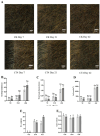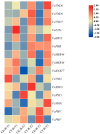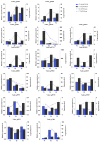The Molecular Mechanism and Effects of Root Pruning Treatment on Blueberry Tree Growth
- PMID: 40805616
- PMCID: PMC12348567
- DOI: 10.3390/plants14152269
The Molecular Mechanism and Effects of Root Pruning Treatment on Blueberry Tree Growth
Abstract
Root pruning can promote the transplanting of young green plants, but the overall impact of pruning on root growth, morphology, and physiological functions remains unclear. This study integrated transcriptomics and physiological analyses to elucidate the effects of root pruning on blueberry growth. Appropriate pruning (CT4) significantly promoted plant growth, with above-ground biomass and leaf biomass significantly increasing compared to the control group within 42 days. Photosynthesis temporarily decreased at 7 days but recovered at 21 and 42 days. Transcriptomics analysis showed that the cellulose metabolism pathway was rapidly activated and influenced multiple key genes in the starch metabolism pathway. Importantly, transcription factors associated with vascular development were also significantly increased at 7, 21, and 42 days after root pruning, indicating their role in regulating vascular differentiation. Enhanced aboveground growth was positively correlated with the expression of photosynthesis-related genes, and the transport of photosynthetic products via vascular tissues provided a carbon source for root development. Thus, root development is closely related to leaf photosynthesis, and changes in gene expression associated with vascular tissue development directly influence root development, ultimately ensuring coordinated growth between aboveground and belowground parts. These findings provide a theoretical basis for optimizing root pruning strategies to enhance blueberry growth and yield.
Keywords: root growth; root pruning; transcriptome; vascular tissue development.
Conflict of interest statement
The authors declare no conflict of interest.
Figures









Similar articles
-
Prescription of Controlled Substances: Benefits and Risks.2025 Jul 6. In: StatPearls [Internet]. Treasure Island (FL): StatPearls Publishing; 2025 Jan–. 2025 Jul 6. In: StatPearls [Internet]. Treasure Island (FL): StatPearls Publishing; 2025 Jan–. PMID: 30726003 Free Books & Documents.
-
Systemic pharmacological treatments for chronic plaque psoriasis: a network meta-analysis.Cochrane Database Syst Rev. 2020 Jan 9;1(1):CD011535. doi: 10.1002/14651858.CD011535.pub3. Cochrane Database Syst Rev. 2020. Update in: Cochrane Database Syst Rev. 2021 Apr 19;4:CD011535. doi: 10.1002/14651858.CD011535.pub4. PMID: 31917873 Free PMC article. Updated.
-
Systemic pharmacological treatments for chronic plaque psoriasis: a network meta-analysis.Cochrane Database Syst Rev. 2021 Apr 19;4(4):CD011535. doi: 10.1002/14651858.CD011535.pub4. Cochrane Database Syst Rev. 2021. Update in: Cochrane Database Syst Rev. 2022 May 23;5:CD011535. doi: 10.1002/14651858.CD011535.pub5. PMID: 33871055 Free PMC article. Updated.
-
Systemic pharmacological treatments for chronic plaque psoriasis: a network meta-analysis.Cochrane Database Syst Rev. 2017 Dec 22;12(12):CD011535. doi: 10.1002/14651858.CD011535.pub2. Cochrane Database Syst Rev. 2017. Update in: Cochrane Database Syst Rev. 2020 Jan 9;1:CD011535. doi: 10.1002/14651858.CD011535.pub3. PMID: 29271481 Free PMC article. Updated.
-
Intravenous magnesium sulphate and sotalol for prevention of atrial fibrillation after coronary artery bypass surgery: a systematic review and economic evaluation.Health Technol Assess. 2008 Jun;12(28):iii-iv, ix-95. doi: 10.3310/hta12280. Health Technol Assess. 2008. PMID: 18547499
References
-
- Cai T., Xu H., Peng D., Yin Y., Yang W., Ni Y., Xu C., Chen X., Xu C., Yang D., et al. Exogenous hormonal application improves grain yield of wheat by optimizing tiller productivity. Field Crops Res. 2014;155:172–183. doi: 10.1016/j.fcr.2013.09.008. - DOI
-
- Yu H., Hu Y., Qi L., Zhang K., Jiang J., Li H., Zhang X., Zhang Z. Hyperspectral detection of moisture content in rice straw nutrient bowl trays based on PSO-SVR. Sustainability. 2023;15:8703. doi: 10.3390/su15118703. - DOI
-
- Löf M., Thomsen A., Madsen P. Sowing and transplanting of broadleaves (Fagus sylvatica L., Quercus robur L., Prunus avium L. and Crataegus monogyna Jacq.) for afforestation of farmland. For. Ecol. Manag. 2004;188:113–123. doi: 10.1016/j.foreco.2003.07.013. - DOI
-
- Allen K.S., Harper R.W., Bayer A., Brazee N.J. A review of nursery production systems and their influence on urban tree survival. Urban For. Urban Green. 2017;21:183–191. doi: 10.1016/j.ufug.2016.12.002. - DOI
-
- Chang X., Zhang J., Wan F., Xian L., Liu Y. Effects of Root Pruning and Size on Growth Traits of Hybrid Poplar Seedlings. Forests. 2024;15:1770. doi: 10.3390/f15101770. - DOI
Grants and funding
LinkOut - more resources
Full Text Sources

